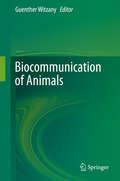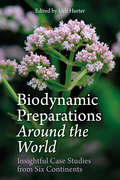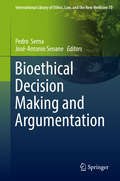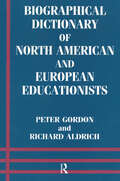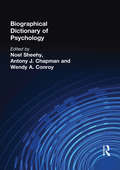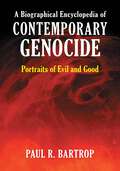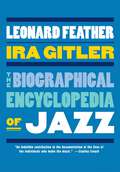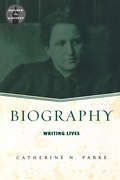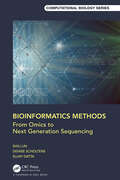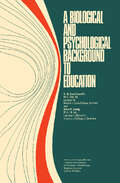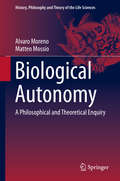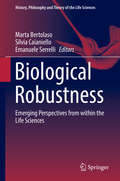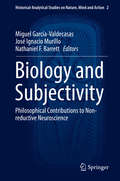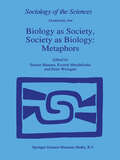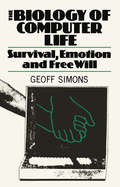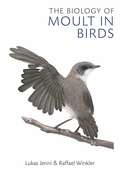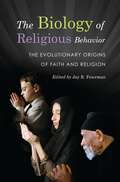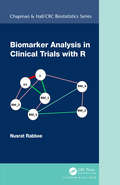- Table View
- List View
Biocommunication of Animals
by Guenther WitzanyEvery coordination within or between animals depends on communication processes. Although the signaling molecules, vocal and tactile signs, gestures and its combinations differ throughout all species according their evolutionary origins and variety of adaptation processes, certain levels of biocommunication can be found in all animal species: (a) Abiotic environmental indices such as temperature, light, water, etc. that affect the local ecosphere of an organism and are sensed, interpreted. (b) Trans-specific communication with non-related organisms.(c) Species-specific communication between same or related species. (d) Intraorganismic communication, i.e., sign-mediated coordination within the body of the organism. This book gives an overview of the manifold levels of animal communication exemplified by a variety of species and thereby broadens the understanding of these organisms.
Biodynamic Preparations Around the World: Insightful Case Studies from Six Continents
by Ueli HurterBiodynamic agriculture first originated in central Europe but is now practised in farms, vineyards and gardens all over the world. At the heart of the biodynamic approach are the eight preparations – Horn manure, Horn silica, Yarrow, Chamomile, Nettle, Oak bark, Dandelion and Valerian – which are often produced by local biodynamic practitioners using well-established recipes. But as the biodynamic approach expands beyond its European origins, its methods have been increasingly adapted to meet the needs and challenges – climates, fauna, seasons and regulations – of different regions around the globe. This fascinating book presents the results of a unique study, carried out by the Agricultural Section at the Goetheanum, Switzerland, into how the biodynamic preparations are used in fifteen countries worldwide, including Egypt, Brazil, New Zealand, India and across Europe. The detailed case studies explore how the preparations are modified to suit their locations, as well as offering an insight into the work of each practitioner and how their understanding has evolved over the years.This book is a valuable reference into the production and application of the preparations around the world and an inspiring endorsement of how biodynamic principles hold true in such varied environments.
Bioethical Decision Making and Argumentation (International Library of Ethics, Law, and the New Medicine #70)
by Pedro Serna José-Antonio SeoaneThis book clarifies the meaning of the most important and pervasive concepts and tools in bioethical argumentation (principles, values, dignity, rights, duties, deliberation, prudence) and assesses the methodological suitability of the main methods for clinical decision-making and argumentation. The first part of the book is devoted to the most developed or promising approaches regarding bioethical argumentation, namely those based on principles, values and human rights. The authors then continue to deal with the contributions and shortcomings of these approaches and suggest further developments by means of substantive and procedural elements and concepts from practical philosophy, normative systems theory, theory of action, human rights and legal argumentation. Furthermore, new models of biomedical and health care decision-making, which overcome the aforementioned criticism and stress the relevance of the argumentative responsibility, are included.
Biographical Dictionary of North American and European Educationists
by Richard Aldrich Peter GordonThis is a guide to the lives and work of more than 500 Americans, Canadians and Europeans in the categories subsumed under the term "educationists". Entries are almost entirely restricted to those with main careers in the 19th and 20th centuries; none of the subjects is still living.
Biographical Dictionary of North American and European Educationists
by Richard Aldrich Peter GordonThis is a guide to the lives and work of more than 500 Americans, Canadians and Europeans in the categories subsumed under the term "educationists". Entries are almost entirely restricted to those with main careers in the 19th and 20th centuries; none of the subjects is still living.
Biographical Dictionary of Psychology
by Noel Sheehy Antony J. Chapman Wenday A. ConroyThe Biographical Dictionary of Psychology provides biographical information and critical analysis of the influences and reception of over 500 people who have made a significant contribution to the field of psychology. Written by an international team of contributors, this volume charts the development of the practice of psychology worldwide from its emergence in the 1850s up to the present day. Biographies range from important historical figures to those who have had a more recent impact on the field, including: * Chris Argyris * Donald Broadbent * Kay Deaux * Leon Festinger * Sigmund Freud * Erich Fromm * Francis Galton * Eleanor Gibson * Doreen Kimur * Ulric Neisser * Jean Piaget * Herbert A. Simon * B.F. Skinner * Amos Tversky Entries are alphabetically organized and similarly structured for ease of access and allowing comparison of information. Introductory biographical details cover main fields of interest, nationality, principal appointments, honours, and places and dates of birth and death. This is followed by full bibliographic details of principal publications, as well as secondary and critical literature which provide a useful route into further research. Following on from there is an invaluable critical appraisal of the major achievements, influences and reception of the psychologists themselves. Thorough indexing allows the reader to access information by American Psychological Association subject division, key concepts, name and institution.
Biographical Dictionary of Psychology
by Noel Sheehy Antony J. Chapman Wendy A. ConroyThe Biographical Dictionary of Psychology provides biographical information and critical analysis of the influences and reception of over 500 people who have made a significant contribution to the field of psychology. Written by an international team of contributors, this volume charts the development of the practice of psychology worldwide from its emergence in the 1850s up to the present day. Biographies range from important historical figures to those who have had a more recent impact on the field, including: * Chris Argyris * Donald Broadbent * Kay Deaux * Leon Festinger * Sigmund Freud * Erich Fromm * Francis Galton * Eleanor Gibson * Doreen Kimur * Ulric Neisser * Jean Piaget * Herbert A. Simon * B.F. Skinner * Amos Tversky Entries are alphabetically organized and similarly structured for ease of access and allowing comparison of information. Introductory biographical details cover main fields of interest, nationality, principal appointments, honours, and places and dates of birth and death. This is followed by full bibliographic details of principal publications, as well as secondary and critical literature which provide a useful route into further research. Following on from there is an invaluable critical appraisal of the major achievements, influences and reception of the psychologists themselves. Thorough indexing allows the reader to access information by American Psychological Association subject division, key concepts, name and institution.
A Biographical Encyclopedia of Contemporary Genocide: Portraits of Evil and Good
by Paul R. BartropThis book documents the devastating effects of genocide in the world's most destructive human environments since the end of World War II and explores why such events still occur.A Biographical Encyclopedia of Contemporary Genocide: Portraits of Evil and Good is a unique study of humanity's most reprehensible actions. It documents genocides that have occurred after World War II—a period that was supposed to be the fulfillment of the promise "never again"—by providing biographies rather than extensive historical narratives.The entries describe the personal backgrounds; careers; and relationship to genocidal events, humanitarian actions, or international initiatives relevant to each person in the book. Beyond examining the genocidaires who played key roles in mass murder, individuals who contributed to efforts to stop genocide are also profiled. By adopting a biographical approach to post-World War II genocide, the author sheds light on why people behave the way they do toward their fellow human beings and provides vital insights into the extremes of human positivity and negativity that have characterized this period of history. Serving as a vital tool for scholars and students of genocide as well as compelling reading for general audiences, the book highlights individual human behaviors, motivations, backgrounds, and intentions that can form a platform from which to raise and discuss issues of morality and ethics in the modern world.
A Biographical Encyclopedia of Contemporary Genocide: Portraits of Evil and Good
by Paul R. BartropThis book documents the devastating effects of genocide in the world's most destructive human environments since the end of World War II and explores why such events still occur.A Biographical Encyclopedia of Contemporary Genocide: Portraits of Evil and Good is a unique study of humanity's most reprehensible actions. It documents genocides that have occurred after World War II—a period that was supposed to be the fulfillment of the promise "never again"—by providing biographies rather than extensive historical narratives.The entries describe the personal backgrounds; careers; and relationship to genocidal events, humanitarian actions, or international initiatives relevant to each person in the book. Beyond examining the genocidaires who played key roles in mass murder, individuals who contributed to efforts to stop genocide are also profiled. By adopting a biographical approach to post-World War II genocide, the author sheds light on why people behave the way they do toward their fellow human beings and provides vital insights into the extremes of human positivity and negativity that have characterized this period of history. Serving as a vital tool for scholars and students of genocide as well as compelling reading for general audiences, the book highlights individual human behaviors, motivations, backgrounds, and intentions that can form a platform from which to raise and discuss issues of morality and ethics in the modern world.
The Biographical Encyclopedia of Jazz
by Leonard Feather & Ira GitlerDo you want to know when Duke Ellington was king of The Cotton Club? Have you ever wondered how old Miles Davis was when he got his first trumpet? From birth dates to gig dates and from recordings to television specials, Leonard Feather and Ira Gitler have left no stone unturned in their quest for accurate, detailed information on the careers of 3.300 jazz musicians from around the world. We learn that Duke Ellington worked his magic at The Cotton Club from 1927 to 1931, and that on Miles Davis's thirteenth birthday, his father gave him his first trumpet. Jazz is fast moving, and this edition clearly and concisely maps out an often dizzying web of professional associations. We find, for instance, that when Miles Davis was a St. Louis teenager he encountered Charlie Parker and Dizzy Gillespie for the first time. This meeting proved fateful, and by 1945 a nineteen-year-old Davis had left Juilliard to play with Parker on 52nd Street. Knowledge of these professional alliances, along with the countless others chronicled in this book, are central to tracing the development of significant jazz movements, such as the "cool jazz" that became one of Miles Davis's hallmarks. Arranged alphabetically according to last name, each entry of this book chronologically lists the highlights of every jazz musician's career. Highly accessible and vigorously researched, The Biographical Encyclopedia of Jazz is, quite simply, the most comprehensive jazz encyclopedia available.
The Biographical Encyclopedia of Jazz
Do you want to know when Duke Ellington was king of The Cotton Club? Have you ever wondered how old Miles Davis was when he got his first trumpet? From birth dates to gig dates and from recordings to television specials, Leonard Feather and Ira Gitler have left no stone unturned in their quest for accurate, detailed information on the careers of 3.300 jazz musicians from around the world. We learn that Duke Ellington worked his magic at The Cotton Club from 1927 to 1931, and that on Miles Davis's thirteenth birthday, his father gave him his first trumpet. Jazz is fast moving, and this edition clearly and concisely maps out an often dizzying web of professional associations. We find, for instance, that when Miles Davis was a St. Louis teenager he encountered Charlie Parker and Dizzy Gillespie for the first time. This meeting proved fateful, and by 1945 a nineteen-year-old Davis had left Juilliard to play with Parker on 52nd Street. Knowledge of these professional alliances, along with the countless others chronicled in this book, are central to tracing the development of significant jazz movements, such as the "cool jazz" that became one of Miles Davis's hallmarks. Arranged alphabetically according to last name, each entry of this book chronologically lists the highlights of every jazz musician's career. Highly accessible and vigorously researched, The Biographical Encyclopedia of Jazz is, quite simply, the most comprehensive jazz encyclopedia available.
Biography: Writing Lives
by Catherine N. ParkeCatherine Parke explores biography through detailed examinations of Samuel Johnson, Virginia Woolf, Langston Hughes, Gertrude Stein and other masters of the genre.
Biography: Writing Lives (Genres In Context Ser.)
by Catherine N. ParkeCatherine Parke explores biography through detailed examinations of Samuel Johnson, Virginia Woolf, Langston Hughes, Gertrude Stein and other masters of the genre.
Bioinformatics Methods: From Omics to Next Generation Sequencing (Chapman & Hall/CRC Computational Biology Series)
by Shili Lin Denise Scholtens Sujay DattaThe past three decades have witnessed an explosion of what is now referred to as high-dimensional `omics' data. Bioinformatics Methods: From Omics to Next Generation Sequencing describes the statistical methods and analytic frameworks that are best equipped to interpret these complex data and how they apply to health-related research. Covering the technologies that generate data, subtleties of various data types, and statistical underpinnings of methods, this book identifies a suite of potential analytic tools, and highlights commonalities among statistical methods that have been developed. An ideal reference for biostatisticians and data analysts that work in collaboration with scientists and clinical investigators looking to ensure rigorous application of available methodologies. Key Features: Survey of a variety of omics data types and their unique features Summary of statistical underpinnings for widely used omics data analysis methods Description of software resources for performing omics data analyses
Bioinformatics Methods: From Omics to Next Generation Sequencing (Chapman & Hall/CRC Computational Biology Series)
by Shili Lin Denise Scholtens Sujay DattaThe past three decades have witnessed an explosion of what is now referred to as high-dimensional `omics' data. Bioinformatics Methods: From Omics to Next Generation Sequencing describes the statistical methods and analytic frameworks that are best equipped to interpret these complex data and how they apply to health-related research. Covering the technologies that generate data, subtleties of various data types, and statistical underpinnings of methods, this book identifies a suite of potential analytic tools, and highlights commonalities among statistical methods that have been developed. An ideal reference for biostatisticians and data analysts that work in collaboration with scientists and clinical investigators looking to ensure rigorous application of available methodologies. Key Features: Survey of a variety of omics data types and their unique features Summary of statistical underpinnings for widely used omics data analysis methods Description of software resources for performing omics data analyses
A Biological and Psychological Background to Education
by Alice F. Laing C. G. HussellA Biological and Psychological Background to Education focuses on man's physical and psychological characteristics which influence education.The publication first underscores the importance of man's biological background, the biological nature of man, and the nature of the vital processes. Discussions focus on respiration, nutrition, object of vital activities, characteristics of man as an animal, primate characteristics, diversity of man, public education, and human biology in the schools. The book then examines the control of vital processes, reproduction and sex education, genetic factors in the life of man, evolution and man, and development and growth. The manuscript takes a look at movement, posture, and exercise, health and the teacher's responsibility, social heritage of man, higher mental processes, and structure of personality. Topics include social factors in personality, remembering and forgetting, intelligence, perception, contemporary pressures in society, prevention of disease, and the significance of levers in the body.The publication is designed for students at colleges of education and colleges of physical education.
Biological Autonomy: A Philosophical and Theoretical Enquiry (History, Philosophy and Theory of the Life Sciences #12)
by Alvaro Moreno Matteo MossioSince Darwin, Biology has been framed on the idea of evolution by natural selection, which has profoundly influenced the scientific and philosophical comprehension of biological phenomena and of our place in Nature. This book argues that contemporary biology should progress towards and revolve around an even more fundamental idea, that of autonomy. Biological autonomy describes living organisms as organised systems, which are able to self-produce and self-maintain as integrated entities, to establish their own goals and norms, and to promote the conditions of their existence through their interactions with the environment.Topics covered in this book include organisation and biological emergence, organisms, agency, levels of autonomy, cognition, and a look at the historical dimension of autonomy. The current development of scientific investigations on autonomous organisation calls for a theoretical and philosophical analysis. This can contribute to the elaboration of an original understanding of life - including human life - on Earth, opening new perspectives and enabling fecund interactions with other existing theories and approaches. This book takes up the challenge.
Biological Robustness: Emerging Perspectives from within the Life Sciences (History, Philosophy and Theory of the Life Sciences #23)
by Marta Bertolaso Silvia Caianiello Emanuele SerrelliThis volume reviews examples and notions of robustness at several levels of biological organization. It tackles many philosophical and conceptual issues and casts an outlook on the future challenges of robustness studies in the context of a practice-oriented philosophy of science. The focus of discussion is on concrete case studies. These highlight the necessity of a level-dependent description of robust biological behaviors.Experts from the neurosciences, biochemistry, ecology, biology, and the history and the philosophy of life sciences provide a multiplex perspective on the topic. Contributions span from protein folding, to cell-level robustness, to organismal and developmental robustness, to sensorimotor systems, up to the robustness of ecological systems.Several chapters detail neurobiological case-studies. The brain, the poster child of plasticity in biology, offers multiple examples of robustness. Neurobiology explores the importance of temporal organization and multiscalarity in making this robustness-with-plasticity possible. The discussion also includes structures well beyond the brain, such as muscles and the complex feedback loops involved in the peculiar robustness of music perception. Overall, the volume grounds general reflections upon concrete case studies, opening to all the life sciences but also to non-biological and bio-inspired fields such as post-modern engineering. It will appeal to researchers, students, as well as non-expert readers.
Biology and Subjectivity: Philosophical Contributions to Non-reductive Neuroscience (Historical-Analytical Studies on Nature, Mind and Action #2)
by Miguel García-Valdecasas José Ignacio Murillo Nathaniel F. BarrettSome may consider that the language and concepts of philosophy will eventually be superseded by those of neuroscience. This book questions such a naïve assumption and through a variety of perspectives and traditions, the authors show the possible contributions of philosophy to non-reductive forms of neuroscientific research. Drawing from the full range and depth of philosophical thought, from hylomorphism to ethics, by way of dynamical systems, enactivism and value theory, amongst other topics, this edited work promotes a rich form of interdisciplinary exchange.Chapters explore the analytic, phenomenological and pragmatic traditions of philosophy, and most share a common basis in the Aristotelian tradition. Contributions address one or more aspects of subjectivity in relation to science, such as the meaning and scope of naturalism and the place of consciousness in nature, or the relation between intentionality, teleology, and causality. Readers may further explore the nature of life and its relation to mind and then the role of value in mind and nature.This book shows how philosophy might contribute to real explanatory progress in science while remaining faithful to the full complexity of the phenomena of life and mind. It will be of interest to both philosophers and neuroscientists, as well as those engaged in interdisciplinary cooperation between philosophy and science.
Biology as Society, Society as Biology: Metaphors (Sociology of the Sciences Yearbook #18)
by Sabine Maasen E. Mendelsohn P. Weingartnot lie in the conceptual distinctions but in the perceived functions of metaphors and whether in the concrete case they are judged positive or negative. The ongoing debates reflect these concerns quite clearly~ namely that metaphors are judged on the basis of supposed dangers they pose and opportunities they offer. These are the criteria of evaluation that are obviously dependent on the context in which the transfer of meaning occurs. Our fundamental concern is indeed the transfer itself~ its prospects and its limits. Looking at possible functions of metaphors is one approach to under standing and elucidating sentiments about them. The papers in this volume illustrate, by quite different examples, three basic functions of metaphors: illustrative, heuristic~ and constitutive. These functions rep resent different degrees of transfer of meaning. Metaphors are illustrative when they are used primarily as a literary device, to increase the power of conviction of an argument, for example. Although the difference between the illustrative and the heuristic function of metaphors is not great, it does exist: metaphors are used for heuristic purposes whenever "differences" of meaning are employed to open new perspectives and to gain new insights. In the case of "constitutive" metaphors they function to actually replace previous meanings by new ones. Sabine Maasen in her paper introduces the distinction between transfer and transforma tion.
The Biology of Computer Life: Survival, Emotion and Free Will
by SIMONSThe doctrine of computer life is not congenial to many people. Often they have not thought in any depth about the idea, and it necessarily disturbs their psychological and intellectual frame of reference: it forces a reappraisal of what it is to be alive, what it is to be human, and whether there are profound, yet un expected, implications in the development of modern com puters. There is abundant evidence to suggest that we are wit nessing the emergence of a vast new family of life-forms on earth, organisms that are not based on the familiar metabolic chemistries yet whose manifest 'life credentials' are accumulating year by year. It is a mistake to regard biology as a closed science, with arbitrarily limited categories; and we should agree with Jacob (1974) who observed that 'Contrary to what is imagined, biology is not a unified science'. Biology is essentially concerned with living things, and we should be reluctant to assume that at anyone time our concept and understanding of life are complete and incapable of further refinement. And it seems clear that much of the continuing refinement of biological categories will be stimulated by advances in systems theory, and in particular by those advances that relate to the rapidly expanding world of computing and robotics. We should also remember what Pant in (1968) said in a different context: 'the biological sciences are unrestricted . . . and their investigator must be prepared to follow their problems into any other science whatsoever.
The Biology of Moult in Birds
by Lukas Jenni Raffael WinklerFeathers are amazing structures unique to birds and, for a variety of reasons, they need to be renewed periodically as a whole in a process called moult. During this process, all of the functions of plumage are impaired and most aspects of a bird's life are affected. Every moult determines a bird's appearance anew, and restores plumage efficacy for flight and insulation. Moult profoundly affects physiology and the organization of the annual cycle, and it constrains reproduction and migration. Given these major impacts, which are equal to the other annual challenges of reproduction and migration, it is surprising that research on moult has largely been so neglected a subject. Lukas Jenni and Raffael Winkler have brought together the widely scattered results of studies on the processes and consequences of moult in birds. This book opens with an overview of the functions of plumage, and of feather maintenance and feather wear, and then introduces the two functions of moult: replacement of worn feathers and adjustment of plumage characteristics and appearance. The body of the book then examines feather-growth and the physiology, energetics and control of moult, and how various other physiological processes interact with moult and may compensate for its costs. Significantly, the authors explain how variations in moult and feather quality affect a bird's overall plumage quality, and they highlight the resulting consequences in terms of physical performance, appearance and signalling. Finally, there is a review of all the various solutions that birds have developed to fit moult into the annual cycle.This long-awaited book covers for the first time all aspects of the biology of moult and fills an important gap in the literature, completing our understanding of how the most important annual events in a bird's life fit together into a coherent whole. It draws on a wide range of information – from penguins to small passerines, from raptors to wildfowl – to highlight the variety of the subject and to pinpoint the many gaps in our knowledge along with avenues for fruitful further research.
The Biology of Moult in Birds
by Lukas Jenni Raffael WinklerFeathers are amazing structures unique to birds and, for a variety of reasons, they need to be renewed periodically as a whole in a process called moult. During this process, all of the functions of plumage are impaired and most aspects of a bird's life are affected. Every moult determines a bird's appearance anew, and restores plumage efficacy for flight and insulation. Moult profoundly affects physiology and the organization of the annual cycle, and it constrains reproduction and migration. Given these major impacts, which are equal to the other annual challenges of reproduction and migration, it is surprising that research on moult has largely been so neglected a subject. Lukas Jenni and Raffael Winkler have brought together the widely scattered results of studies on the processes and consequences of moult in birds. This book opens with an overview of the functions of plumage, and of feather maintenance and feather wear, and then introduces the two functions of moult: replacement of worn feathers and adjustment of plumage characteristics and appearance. The body of the book then examines feather-growth and the physiology, energetics and control of moult, and how various other physiological processes interact with moult and may compensate for its costs. Significantly, the authors explain how variations in moult and feather quality affect a bird's overall plumage quality, and they highlight the resulting consequences in terms of physical performance, appearance and signalling. Finally, there is a review of all the various solutions that birds have developed to fit moult into the annual cycle.This long-awaited book covers for the first time all aspects of the biology of moult and fills an important gap in the literature, completing our understanding of how the most important annual events in a bird's life fit together into a coherent whole. It draws on a wide range of information – from penguins to small passerines, from raptors to wildfowl – to highlight the variety of the subject and to pinpoint the many gaps in our knowledge along with avenues for fruitful further research.
The Biology of Religious Behavior: The Evolutionary Origins of Faith and Religion (Non-ser.)
by Jay R. FeiermanOffers a fresh and detailed take on the evolution of religious behavior from a biobehavioral perspective, promoting a new understanding that may help build bridges across the religious divide.There has been much recent interest in the study of religion from the perspective of Darwinian evolution. The Biology of Religious Behavior: The Evolutionary Origins of Faith and Religion offers a broad overview of the topic, written by internationally recognized experts. In addition to its primary focus on religious behavior, the book addresses other important aspects of religion, such as values, beliefs, and emotions as they affect behavior. The contributors approach the evolution of religion by examining the behavior of individuals in their everyday lives. After describing various religious behaviors, the contributors consider the behaviors with reference to their evolutionary history, development during the lifetime of the individual, proximate causes, and adaptive value. Happily, this foray into understanding religion from a biobehavioral perspective demonstrates that, at the biological and behavioral levels, what unites the different religions of the world is far greater than what divides them.
Biomarker Analysis in Clinical Trials with R (Chapman & Hall/CRC Biostatistics Series)
by Nusrat RabbeeThe world is awash in data. This volume of data will continue to increase. In the pharmaceutical industry, much of this data explosion has happened around biomarker data. Great statisticians are needed to derive understanding from these data. This book will guide you as you begin the journey into communicating, understanding and synthesizing biomarker data. -From the Foreword, Jared Christensen, Vice President, Biostatistics Early Clinical Development, Pfizer, Inc. Biomarker Analysis in Clinical Trials with R offers practical guidance to statisticians in the pharmaceutical industry on how to incorporate biomarker data analysis in clinical trial studies. The book discusses the appropriate statistical methods for evaluating pharmacodynamic, predictive and surrogate biomarkers for delivering increased value in the drug development process. The topic of combining multiple biomarkers to predict drug response using machine learning is covered. Featuring copious reproducible code and examples in R, the book helps students, researchers and biostatisticians get started in tackling the hard problems of designing and analyzing trials with biomarkers. Features: Analysis of pharmacodynamic biomarkers for lending evidence target modulation. Design and analysis of trials with a predictive biomarker. Framework for analyzing surrogate biomarkers. Methods for combining multiple biomarkers to predict treatment response. Offers a biomarker statistical analysis plan. R code, data and models are given for each part: including regression models for survival and longitudinal data, as well as statistical learning models, such as graphical models and penalized regression models. Nusrat Rabbee is a biostatistician and data scientist at Rabbee & Associates, where she creates innovative solutions to help companies accelerate drug and diagnostic development for patients. Her research interest lies in the intersection of data science and personalized medicine. She has extensive experience in bioinformatics, clinical statistics and high-dimensional data analyses. She has co-discovered the RLMM algorithm for genotyping Affymetrix SNP chips and co-invented a high-dimensional molecular signature for cancer. She has spent over 17 years in the pharmaceutical and diagnostics industry focusing on biomarker development. She has taught statistics at UC Berkeley for 4 years.
